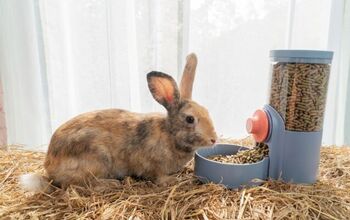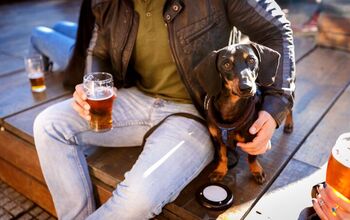What Should I Do If My Dog is Resource Guarding?

Does your dog growl every time you get near their food dish? Do they snap at any other dog that tries to touch their favorite toys? If so, you may be dealing with resource guarding in dogs. The number of dogs exhibiting this behavior is hard to track, but one thing is certain – you are not alone! This is a natural behavior that dates back to your dog’s ancestors, but it can be changed.
Addressing and breaking this behavior isn’t easy and can take a long time to work through. In the meantime, you must manage the situation to keep your dog and everyone around them (especially children and other pets) safe.
In this article, you will learn what resource guarding is, the potential triggers that may cause your dog to act this way, and how you can start working towards a solution today!
What is Resource Guarding?
If you have stumbled across this article, you may be wondering: what exactly IS resource guarding anyway? At its core, the term “ resource guarding” refers to an attempt by a dog to protect or assert ownership over something they deem important or valuable.
Often, when we talk about this behavior, it is associated with food, treats, or toys, but it can extend beyond that. Some dogs will become protective over a shared water dish, bed, or even their favorite person.
There are many ways your dog may communicate this ownership. Some dogs will stiffen and stare hard at the perceived threat, while others will growl, bark, lunge, or even try to bite if someone (human, dog, cat, or other threat) is getting close to their valued item.
In the wild, this behavior allowed your dog’s ancestors to boost their chance of survival by holding onto any necessities they have collected. Unfortunately, in a domesticated dog, this behavior can be incredibly problematic.
Is Resource Guarding Always Aggressive?
While it could be argued that resource-guarding behavior isn’t always “aggressive,” it always has the potential to escalate to aggressive behavior. Some dogs will communicate a warning by stiffening their body, placing themselves between the perceived threat and the valuable item, covering the valuable thing with their head or paws, or staring intensely at the perceived threat.
These behaviors may not seem concerning at the time. After all, your dog is not actively trying to cause harm to anyone around them. But a warning should always be taken seriously. If the situation is not addressed, your dog may feel they must move to the next stage to protect what’s theirs.
What Triggers Resource Guarding in Dogs?
To better understand why your dog is acting this way, you must identify the behavior's root cause. This could date back to early in your dog’s life, so it may require some careful reflection. If you have adopted an older dog and don’t know their past, you still may be able to identify signs that point to one of these triggers.
Fear and Anxiety
If your dog feels fear or anxiety, they may find comfort in a particular item or element of their environment. The heightened stress they feel from these emotions, combined with a reliance upon the valued item, can lead to resource guarding. For example, if you have recently moved to a new house and your dog runs to their bed every time they appear stressed or upset, this could cause them to develop a protectiveness over the bed, aka their “safe space.”
Previously Limited Resources
Did your dog have a rough start to their life? If so, they may be guarding their resources because they had to for survival in the past. This trigger is common in dogs rescued from neglectful or abusive homes, puppy mills, or hoarding situations.
Poor Training Methods
With so much conflicting information available online, it should come as no surprise that there are a lot of well-meaning dog parents who make poor choices in terms of training methods. For example, many “trainers” (using the word loosely) still recommend periodically taking a dog’s chews away to avoid this behavior. However, doing this can trigger the behavior because you show your dog that you may take away their prized possessions at any time if they don’t protect them.
This also applies to dogs trained by withholding food, a harsh training approach that relies on making your dog hungry so that they are more desperate to do as you command to “earn” the food they need. You may not have used this approach yourself but mistakenly trusted an inexperienced trainer who did. This creates a feeling of scarcity, which takes us back to the previous reason on our list.
Conflict or Trauma
Dogs that experience trauma related to their valued possession may conclude they have to stand up and protect it moving forward. This can happen if, in a group setting, your dog is bullied or picked on, resulting in having the things they value taken away. A friend’s dog never had resource guarding issues until they started attending doggy daycare. In speaking with the daycare workers, she found out that her dog was being “occasionally picked on” during playtime. For her dog, this wasn’t innocent play. Instead, it led to guarding his toys so no one else could take them away.
Lack of Socialization
Was your dog socialized and taught how to interact with other dogs at a young age? If not, they simply may not understand the concept of “sharing.” You can think of it as an only child who is never taught to play well with others and throws tantrums if they don’t get their way.
Poor Genetics/Breeding
Like any behavior, some dogs may be more likely to develop resource-guarding habits due to poor genetics. For example, if dogs with anxiety issues aren’t removed from breeding, it can result in even more dogs with severe anxiety. As we previously established, anxiety can trigger resource guarding.
What Breeds Are More Prone to Resource Guarding?
Truthfully, any dog can develop problem behaviors like resource guarding. It is not exclusive to any breed or breed group. However, some breeds may be more likely to exhibit this behavior due to their traits or purpose in life. Retrieving breeds may be more likely to resource guard the items they retrieve. Some working breeds, specifically those trained to protect herds, may develop this behavior due to their instinct to protect.
While there is no definitive proof, many professionals believe that Cocker Spaniels are a high-risk breed. They are at risk for a condition called Cocker Rage, a sudden onset aggression towards people or things. This has also been associated with other spaniel breeds, like springer spaniels.
But don’t forget – any dog or breed can struggle with resource guarding!
6 Tips to Effectively Stop Resource Guarding
A dog that exhibits resource-guarding behaviors can be a significant liability, especially if you have small children or other pets in the household that you need to be concerned about. But does resource guarding mean you need to begin exploring the idea of rehoming? Can Resource Guarding Be Fixed? The good news is that this behavior, like most unwanted behaviors, can be fixed in most cases! However, it is going to require commitment on your part.
I will take a moment to acknowledge that there are some severe cases where, even after exhaustive efforts from professional trainers and behaviorists, it may be recommended to rehome your dog to reduce the triggers and manage their behavior moving forward vs. stopping it. But don’t jump to this “worst-case scenario” until you have explored your options.
Here are a few tips to help you get started with your journey to stop resource guarding in your dog:
Acknowledge the Severity of the Situation
The first thing we need to do as dog parents when we notice any behavioral issue is to acknowledge that it is serious and does require our immediate attention. Far too often, we see videos circulating social media where people believe it is funny to see a little Chihuahua growling as they reach for its teddy bear. This isn’t funny. It isn’t cute. Regardless of your dog’s breed, age, or size – resource guarding can create an unsafe situation for you, your dog, and those around you. Don’t downplay your dog’s behavior or try to explain it away. Instead, be honest with yourself that there IS a problem and start making an action-driven plan to address it.
Always Provide Plenty of Resources
Take inventory of what resources you have in your home and whether they are sufficient for the number of pets that are sharing them. Your dog is telling you that sharing is a problem – so ensure that there are enough for every pet to have their own. This could mean adding a water dish, splitting toys into multiple toy bins, or placing an extra dog bed in your room. Even if they previously shared these items, offer them their own moving forward.
Separate Your Dog from Children and Other Pets
While you likely don’t want to keep your dog separate from everyone in the household 24/7, you can significantly reduce the risk by separating them from young children and other pets who may not know to “leave them alone” during mealtimes or when enjoying a special high-value treat. In fact, keeping your children away from your dog while they are eating is a good practice, even if a dog isn’t resource-guarding.
Plenty of Mental and Physical Enrichment
Have you ever heard the saying, “A tired dog is a good dog” or something similar? This saying is rooted in one genuine truth – boredom drives a lot of unwanted behaviors in our dogs. The best way to reduce the risk that your dog’s resource guarding could be triggered by boredom is to find ways to incorporate mental and physical exercise into your daily routine.
The most common solution for this is to take your dog for a walk or play a game of fetch. However, there are many other creative ways to keep your dog’s mind and body working hard. The amount of enrichment needed for your dog will vary depending on several factors, including age and breed. For example, our senior girl, Daviana, sleeps much longer and doesn’t require nearly as much activity as our young German Shepherd/Australian Cattle Dog, Lucifer.
Some fun products or activities you can use to provide your dog with more enrichment opportunities include:
- Interactive Toys (Like Treat-Dispensing Toys)
- Scent Games
- Food Puzzles
- Games of Hide-and-Seek
- Training Sessions
- Build an Obstacle Course
- Build a DIY Busy Box
Teach Commands Like “Drop It” and “Leave It” with Rewards
When working through basic obedience training commands like “drop it” or “leave it” with a positive reinforcement approach, you teach your dog to trade whatever item they have and deem valuable for something even better. This idea of “trading up” helps teach your dog that better options are available than becoming overprotective of a single item. If you notice your dog is starting to show signs of being possessive or guarding an item, the “drop it” command can also be helpful to take control of the situation and move your dog out of it safely.
Give, Don’t Take
Following the same line of thought, your work with your dog should always be focused on teaching them that others being around their item of value means they will get something worthwhile, not that something will be taken away. If you buy into the old-school training school of thought and take your dog’s food dish away each time they show a resource-guarding behavior, you are teaching them that they should guard the item even more, even from you, or they will lose it and end up with nothing. This can escalate the behavior considerably.
Instead, you want your dog to realize that someone coming near when they are with their valuable item brings the potential for good surprises.
One way to do this is to have a handful of treats or kibble while your dog eats. Walk by your dog (only as close as you can without pushing your dog over the threshold) and throw kibble or treats into their dish or in their direction. Over time, you will be able to move closer while doing this because your dog knows you are bringing something good.
When Should You Seek Professional Help?
If you have been working through the above tips with no sign of things improving, or if your dog’s resource guarding behaviors have escalated to the point that you are concerned it could be dangerous (aggressive tendencies, young children or other pets at risk, etc.), then it is time to get professional assistance. Look for a dog trainer or certified behaviorist with experience in this area.
Asking for help is not a sign of weakness or failure but a sign of strength. It shows you are willing to invest in your dog’s future and work towards a better life together.
Final Thoughts: Resource Guarding in Dogs
If your dog shows signs of resource guarding, you’re not alone and the situation is not hopeless. In the short term, focus on managing the situation to keep everyone safe. This could mean feeding your dog in a separate room or preventing other pets and young children from entering the space that contains your dog’s bed and toy box.
Training and conditioning should be focused on positive reinforcement, teaching your dog that they don’t have to guard and protect these items of value because better things are coming their way. If you cannot make progress yourself or worry that your dog’s behavior has advanced too far and could create a dangerous situation, contact an experienced trainer or certified behaviorist to help you break this bad habit.
This isn’t a problem that can be solved overnight, but with plenty of time and effort, most dogs can overcome resource guarding.

Britt Kascjak is a proud pet mom, sharing her heart (and her home) with her “pack” which includes her husband John, their 2 dogs – Lucifer and Willow – and their 2 cats – Pippen and Jinx. She has been active in the animal rescue community for over 15 years, volunteering, fostering and advocating for organizations across Canada and the US. In her free time, she enjoys traveling around the country camping, hiking, and canoeing with her pets.
More by Britt
























